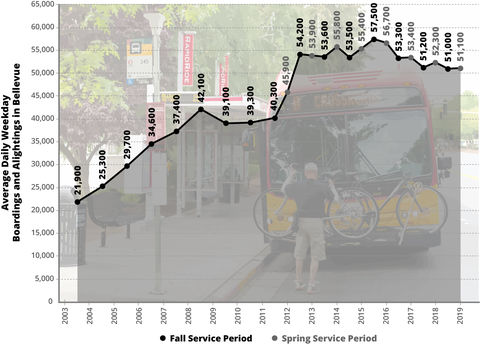
The City collaborates with local, regional, and private sector partners to plan, facilitate, monitor, and evaluate public transit services operated by King County Metro and Sound Transit.
The Transportation Department leverages data from operators to monitor transit performance. Progress toward achieving the transit service vision identified in the 2014 Bellevue Transit Master Plan is measured by service use, service availability, person throughput and transit travel time (see the Measures of Effectiveness Report).
The Trends in Transit interactive map presents information about the number of people who get on and off the bus on an average weekday in Bellevue. Data is presented twice annually since 2012 by stop, route, and area. The chart below summarizes the trend line for daily boardings and alightings since 2003.
Crossroads Connect was a pilot partnership between City of Bellevue, King County Metro, Hopelink and Spare Labs, offering riders on-demand transit service to and from transit hubs in the Crossroads and Lake Hills neighborhoods in Bellevue, an area with a diverse population, lower household incomes, a high percentage of residents with disabilities, and lower car ownership rates compared to other areas in the county and the city. The one-year service pilot operated from October 2020 through September 2021 (see report).
Ride2 was an on-demand, van-based shuttle service funded by King County Metro that supported the fixed-route public transit system, connecting people from their homes, schools and job sites to the Eastgate Park & Ride. The pilot service launched on Oct. 23, 2018, and concluded after 12 months (see Metro's summary report).
The Eastgate Mobility Hub Vision 2025 brochure outlines a conceptual vision for transforming the Eastgate Park & Ride facility into a regional mobility hub by 2025. This project was developed in partnership between King County Metro, the City of Bellevue and Eastgate stakeholders, including the Washington State Department of Transportation and Sound Transit.
